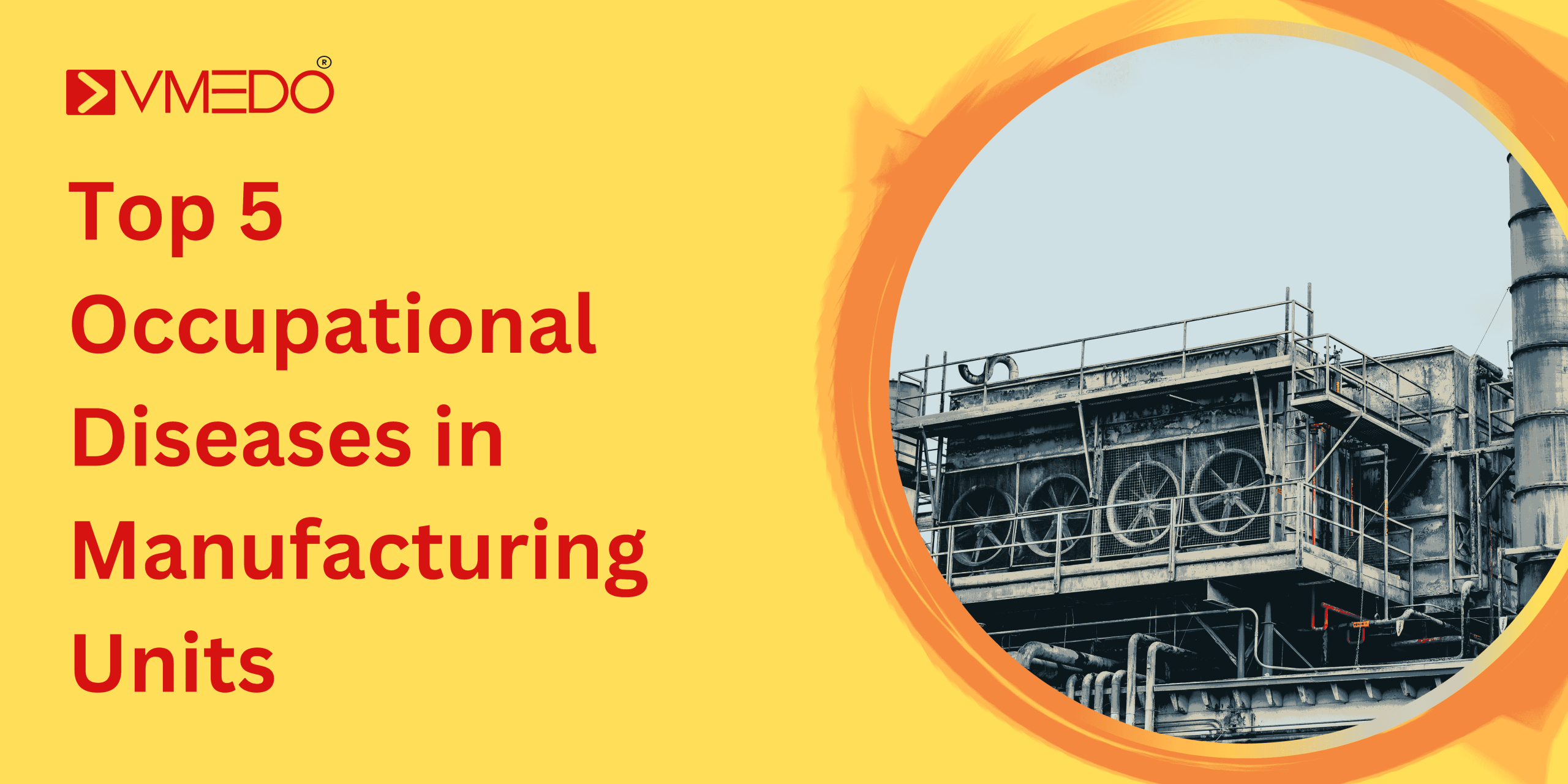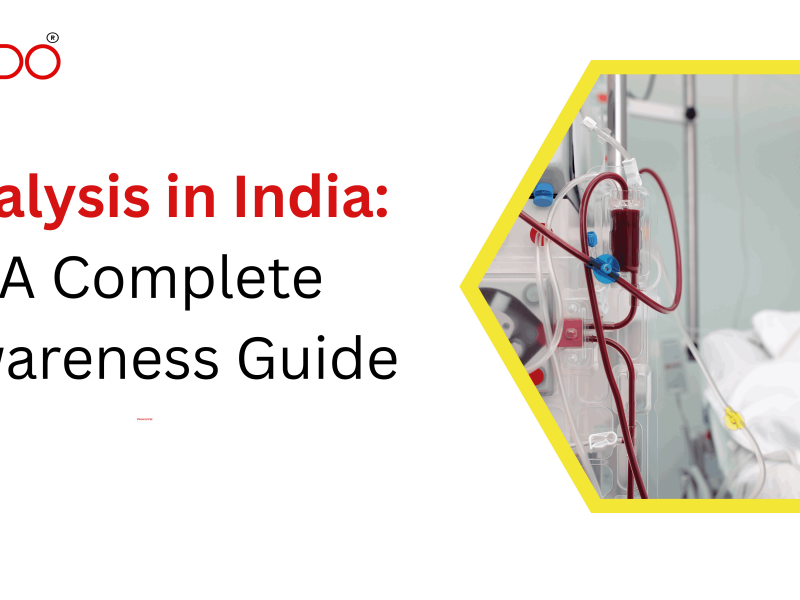Manufacturing powers industry growth — but it also exposes workers to hazards that can cause chronic, disabling illnesses. Under the OSHWC Code, 2020, employers must proactively protect worker health. Identifying the most common occupational diseases in manufacturing units and acting early reduces risk, improves productivity, and strengthens compliance. This article examines the top five occupational diseases in manufacturing units, their workplace causes, prevention measures, practical controls, and how VMEDO supports employers in building a safer and healthier workforce.
1. Respiratory Diseases (occupational asthma, pneumoconiosis, COPD)
Why it happens
Manufacturing processes often generate dust, fibers, fumes, and chemical vapors. Long-term inhalation—especially without controls—can cause occupational asthma, pneumoconiosis (dust-related fibrosis), and chronic obstructive pulmonary disease (COPD).
Common industries & exposures
Cement, foundries, textiles, stone cutting, and chemical plants are high-risk. Silica, asbestos, metal fumes, and solvent vapors are typical culprits.
Signs & impact
Chronic cough, breathlessness, reduced exercise tolerance, and repeated chest infections. Productivity drops, absenteeism rises, and severe cases may lead to permanent disability.
Prevention & controls (practical)
- Elimination/substitution: Replace hazardous materials where feasible.
- Engineering controls: Local exhaust ventilation, dust suppression, and enclosed processes.
- Administrative controls: Job rotation, exposure time limits, and housekeeping.
- PPE: Proper respirators selected for the hazard and fit-tested.
- Medical surveillance: Baseline and periodic Pulmonary Function Tests (PFTs) and respiratory questionnaires.
VMEDO conducts on-site PFT camps, occupational exposure assessments, and periodic surveillance reporting to track lung-function trends and guide control measures.
2. Noise-Induced Hearing Loss (NIHL)
Why it happens
Continuous exposure to sound levels above safe limits (typically >85 dB) damages the inner ear. In many plants, machinery, presses, and compressors produce such levels.
Common industries & exposures
Metal fabrication, stamping, textile looms, heavy machine shops, and woodworking.
Signs & impact
Gradual hearing loss, difficulty understanding speech in noisy areas, reduced safety (missed alarms), and social/psychological effects.
Prevention & controls (practical)
- Engineering: Maintain/muffle noisy equipment, install silencers and barriers.
- Layout: Isolate noisy machines and create buffer zones.
- Administrative: Limit exposure time, rotate workers.
- PPE: Provision of earmuffs/earplugs and regular fit-checks.
- Surveillance: Baseline and periodic audiometry to detect early threshold shifts.
VMEDO organizes audiometry testing on-site, provides trend reports by department, and recommends engineering upgrades based on measured noise maps.
3. Musculoskeletal Disorders (MSDs)
Why it happens
Repetitive tasks, awkward postures, heavy lifting, and static standing lead to strains and cumulative trauma injuries—back pain, neck pain, tendonitis, and carpal tunnel syndrome.
Common industries & exposures
Assembly lines, packaging, material handling, and tasks requiring repetitive hand/arm motions.
Signs & impact
Pain, reduced range of motion, decreased throughput, increased days lost to sick leave, and compensation claims.
Prevention & controls (practical)
- Ergonomic design: Adjustable workstations, anti-fatigue mats, and powered lifters.
- Task design: Job rotation, micro-breaks, and split tasks to reduce repetition.
- Training: Safe lifting techniques and posture awareness.
- Early intervention: On-site physiotherapy, stretching programs, and quick triage of symptoms.
VMEDO offers ergonomic assessments, physiotherapy-led interventions, and injury-trend dashboards to prioritize corrective actions.
4. Skin Diseases (occupational dermatitis and contact allergies)
Why it happens
Direct contact with irritants, solvents, acids, alkalis, and allergens causes irritant or allergic contact dermatitis. Repeated wet work also increases risk.
Common industries & exposures
Paints and coatings, plating, chemical processing, textiles, and cleaning operations.
Signs & impact
Redness, itching, blistering, chronic eczema, and in severe cases, open lesions that risk secondary infection. Affects work attendance and productivity.
Prevention & controls (practical)
- Substitution: Use less irritating formulations where possible
- Engineering: Contain splashes and automate hazardous steps.
- PPE: Gloves (correct material), aprons, and barrier creams.
- Hygiene: Handwashing stations, skin care programs, and no-contact policies for contaminated clothing.
- Surveillance: Pre-placement skin checks and periodic dermatology reviews.
VMEDO runs on-site dermatology screening, crafts chemical-specific glove matrices, and provides employee education on skin hygiene.
5. Occupational Cancers (from carcinogen exposure)
Why it happens
Long-term exposure to certain chemicals and particulates—benzene, formaldehyde, asbestos, some metal compounds and dyes—raises cancer risk. Effects appear after long latency periods.
Common industries & exposures
Chemical manufacturing, painting, rubber, metalworking, and industries that historically used asbestos.
Signs & impact
Cancers may appear years after exposure. They carry severe health, financial, and reputational consequences for employers.
Prevention & controls (practical)
- Substitution & phase-out of known carcinogens.
- Containment & automation to reduce worker contact.
- Strict exposure monitoring (air sampling) and biological monitoring where relevant.
- Strict PPE & hygiene to prevent ingestion or dermal absorption.
- Medical surveillance including targeted screening programs for high-risk cohorts.
VMEDO helps implement exposure monitoring programs, biological testing where needed, long-term medical recordkeeping, and tailored screening strategies.
Proactive occupational health saves money. Early detection reduces long-term medical costs, lowers disability payouts, and increases productive workdays. It also reduces regulatory risk under OSHWC 2020 and improves employer branding—important for recruitment and retention.
Practical implementation roadmap for employers
- Risk mapping: Identify high-risk processes and worker groups.
- Baseline medicals: Pre-employment exams tailored to exposure.
- Periodic surveillance: Annual or more frequent checks depending on risk.
- Engineering fixes: Prioritize controls with measurable impact.
- Training & behavior: Continuous worker training and health promotion.
- Records & audits: Maintain secure digital medical records and compliance files.
VMEDO supports every step with turnkey execution and compliance-ready documentation.
FAQs: Top 5 Occupational Diseases Common in Manufacturing Units
Q1. Are occupational health checks mandatory under OSHWC 2020?
Yes. OSHWC 2020 emphasizes pre-employment and periodic medical examinations for workers in hazardous processes. Frequency and tests depend on industry risk.
Q2. How often should workers be medically screened?
At minimum pre-employment and annually. High-risk roles (silica, heavy metals, high noise) often need more frequent checks—every 6–12 months.
Q3. Who pays for medical surveillance?
The employer is responsible for costs related to statutory occupational health checks and surveillance.
Q4. Can early screening really reduce long-term costs?
Yes—early detection reduces time off work, prevents progression to chronic disability, and lowers treatment and compensation costs.
Q5. How does VMEDO ensure confidentiality?
VMEDO stores medical records on secure digital platforms with role-based access, and shares only authorized, anonymized compliance summaries with management.
Manufacturing units face predictable occupational disease risks—but they are also eminently preventable with the right mix of engineering controls, surveillance, training, and early medical intervention. For employers, the ROI is clear: safer workplaces, lower costs, and regulatory resilience under OSHWC 2020



